Detailed Analysis of Business Combinations and Consolidation Practices
VerifiedAdded on 2019/11/08
|8
|2269
|227
Report
AI Summary
This report provides a detailed analysis of business combinations and consolidated financial statements, focusing on the application of AASB 3 and AASB 10. It defines business combinations, acquisition methods, and the recognition of goodwill and bargain purchases. The report examines the amortization and impairment of goodwill, along with the prohibition of reversal of impairment losses. It further explores consolidated financial statements, including the application of AASB 10, the concept of control, and the process of preparing consolidated financial statements. The report also addresses associates, the equity method of accounting, and joint arrangements, providing a comprehensive overview of the relevant accounting standards and their practical implications, using Nearmap's financial disclosures as a case study.
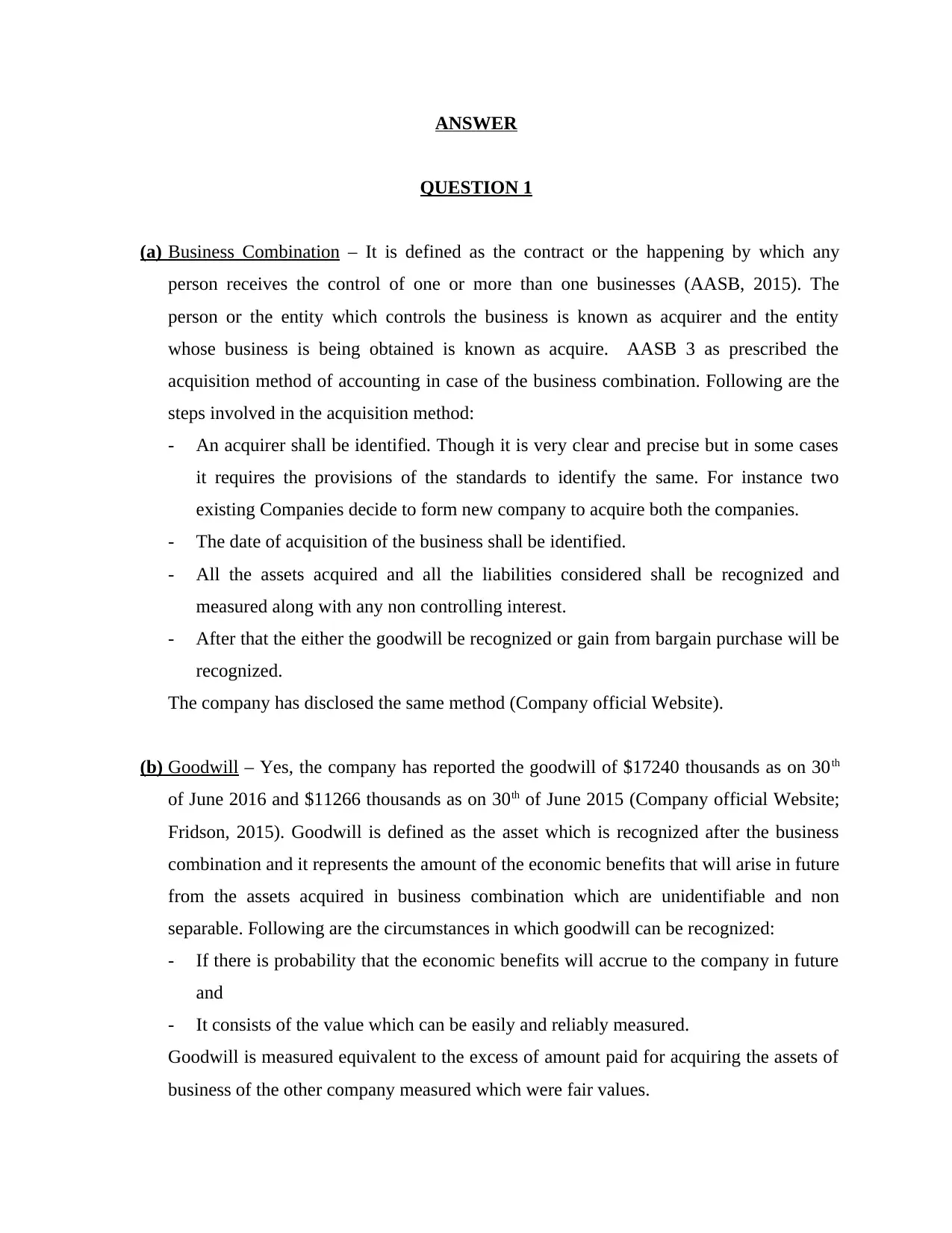
ANSWER
QUESTION 1
(a) Business Combination – It is defined as the contract or the happening by which any
person receives the control of one or more than one businesses (AASB, 2015). The
person or the entity which controls the business is known as acquirer and the entity
whose business is being obtained is known as acquire. AASB 3 as prescribed the
acquisition method of accounting in case of the business combination. Following are the
steps involved in the acquisition method:
- An acquirer shall be identified. Though it is very clear and precise but in some cases
it requires the provisions of the standards to identify the same. For instance two
existing Companies decide to form new company to acquire both the companies.
- The date of acquisition of the business shall be identified.
- All the assets acquired and all the liabilities considered shall be recognized and
measured along with any non controlling interest.
- After that the either the goodwill be recognized or gain from bargain purchase will be
recognized.
The company has disclosed the same method (Company official Website).
(b) Goodwill – Yes, the company has reported the goodwill of $17240 thousands as on 30th
of June 2016 and $11266 thousands as on 30th of June 2015 (Company official Website;
Fridson, 2015). Goodwill is defined as the asset which is recognized after the business
combination and it represents the amount of the economic benefits that will arise in future
from the assets acquired in business combination which are unidentifiable and non
separable. Following are the circumstances in which goodwill can be recognized:
- If there is probability that the economic benefits will accrue to the company in future
and
- It consists of the value which can be easily and reliably measured.
Goodwill is measured equivalent to the excess of amount paid for acquiring the assets of
business of the other company measured which were fair values.
QUESTION 1
(a) Business Combination – It is defined as the contract or the happening by which any
person receives the control of one or more than one businesses (AASB, 2015). The
person or the entity which controls the business is known as acquirer and the entity
whose business is being obtained is known as acquire. AASB 3 as prescribed the
acquisition method of accounting in case of the business combination. Following are the
steps involved in the acquisition method:
- An acquirer shall be identified. Though it is very clear and precise but in some cases
it requires the provisions of the standards to identify the same. For instance two
existing Companies decide to form new company to acquire both the companies.
- The date of acquisition of the business shall be identified.
- All the assets acquired and all the liabilities considered shall be recognized and
measured along with any non controlling interest.
- After that the either the goodwill be recognized or gain from bargain purchase will be
recognized.
The company has disclosed the same method (Company official Website).
(b) Goodwill – Yes, the company has reported the goodwill of $17240 thousands as on 30th
of June 2016 and $11266 thousands as on 30th of June 2015 (Company official Website;
Fridson, 2015). Goodwill is defined as the asset which is recognized after the business
combination and it represents the amount of the economic benefits that will arise in future
from the assets acquired in business combination which are unidentifiable and non
separable. Following are the circumstances in which goodwill can be recognized:
- If there is probability that the economic benefits will accrue to the company in future
and
- It consists of the value which can be easily and reliably measured.
Goodwill is measured equivalent to the excess of amount paid for acquiring the assets of
business of the other company measured which were fair values.
Paraphrase This Document
Need a fresh take? Get an instant paraphrase of this document with our AI Paraphraser
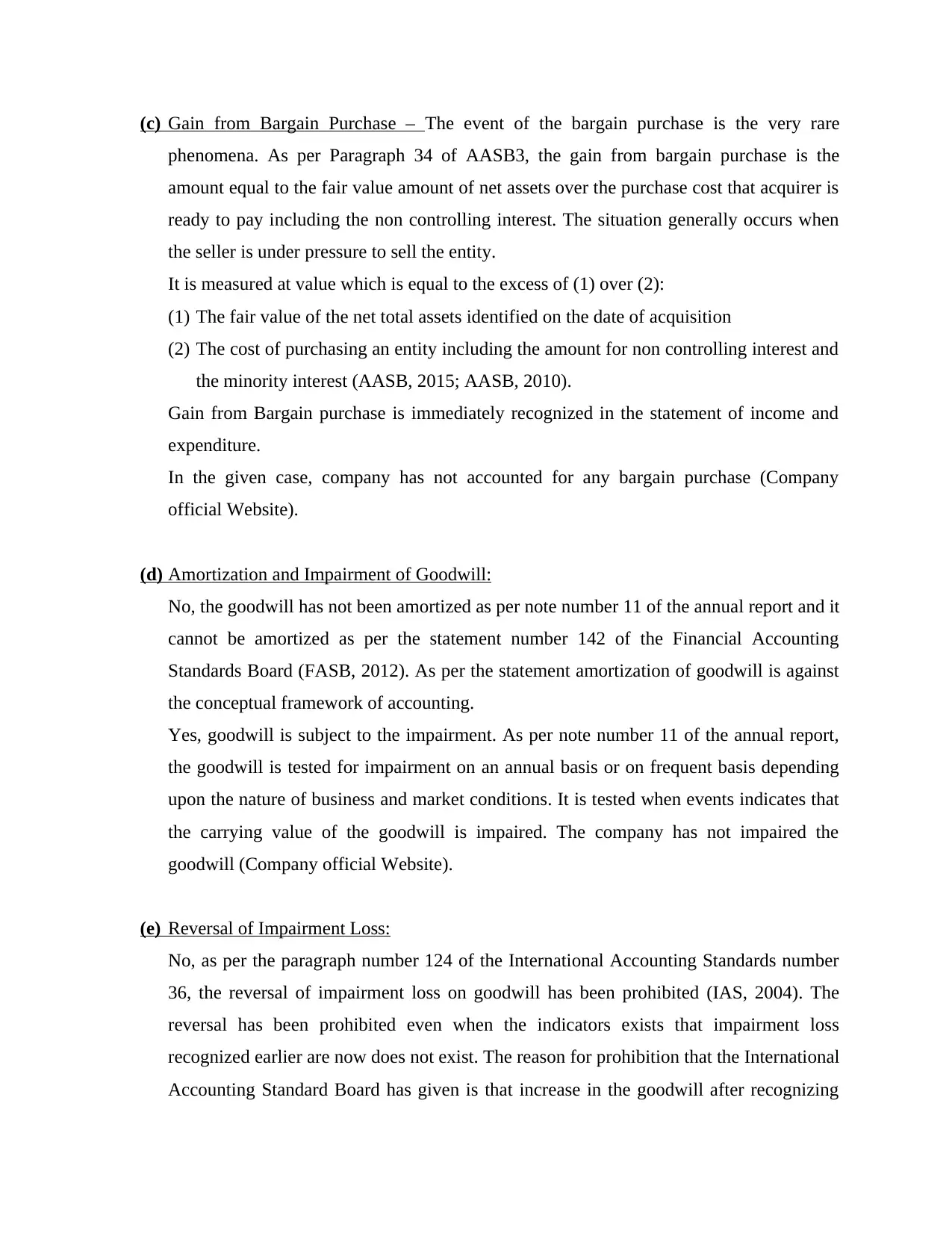
(c) Gain from Bargain Purchase – The event of the bargain purchase is the very rare
phenomena. As per Paragraph 34 of AASB3, the gain from bargain purchase is the
amount equal to the fair value amount of net assets over the purchase cost that acquirer is
ready to pay including the non controlling interest. The situation generally occurs when
the seller is under pressure to sell the entity.
It is measured at value which is equal to the excess of (1) over (2):
(1) The fair value of the net total assets identified on the date of acquisition
(2) The cost of purchasing an entity including the amount for non controlling interest and
the minority interest (AASB, 2015; AASB, 2010).
Gain from Bargain purchase is immediately recognized in the statement of income and
expenditure.
In the given case, company has not accounted for any bargain purchase (Company
official Website).
(d) Amortization and Impairment of Goodwill:
No, the goodwill has not been amortized as per note number 11 of the annual report and it
cannot be amortized as per the statement number 142 of the Financial Accounting
Standards Board (FASB, 2012). As per the statement amortization of goodwill is against
the conceptual framework of accounting.
Yes, goodwill is subject to the impairment. As per note number 11 of the annual report,
the goodwill is tested for impairment on an annual basis or on frequent basis depending
upon the nature of business and market conditions. It is tested when events indicates that
the carrying value of the goodwill is impaired. The company has not impaired the
goodwill (Company official Website).
(e) Reversal of Impairment Loss:
No, as per the paragraph number 124 of the International Accounting Standards number
36, the reversal of impairment loss on goodwill has been prohibited (IAS, 2004). The
reversal has been prohibited even when the indicators exists that impairment loss
recognized earlier are now does not exist. The reason for prohibition that the International
Accounting Standard Board has given is that increase in the goodwill after recognizing
phenomena. As per Paragraph 34 of AASB3, the gain from bargain purchase is the
amount equal to the fair value amount of net assets over the purchase cost that acquirer is
ready to pay including the non controlling interest. The situation generally occurs when
the seller is under pressure to sell the entity.
It is measured at value which is equal to the excess of (1) over (2):
(1) The fair value of the net total assets identified on the date of acquisition
(2) The cost of purchasing an entity including the amount for non controlling interest and
the minority interest (AASB, 2015; AASB, 2010).
Gain from Bargain purchase is immediately recognized in the statement of income and
expenditure.
In the given case, company has not accounted for any bargain purchase (Company
official Website).
(d) Amortization and Impairment of Goodwill:
No, the goodwill has not been amortized as per note number 11 of the annual report and it
cannot be amortized as per the statement number 142 of the Financial Accounting
Standards Board (FASB, 2012). As per the statement amortization of goodwill is against
the conceptual framework of accounting.
Yes, goodwill is subject to the impairment. As per note number 11 of the annual report,
the goodwill is tested for impairment on an annual basis or on frequent basis depending
upon the nature of business and market conditions. It is tested when events indicates that
the carrying value of the goodwill is impaired. The company has not impaired the
goodwill (Company official Website).
(e) Reversal of Impairment Loss:
No, as per the paragraph number 124 of the International Accounting Standards number
36, the reversal of impairment loss on goodwill has been prohibited (IAS, 2004). The
reversal has been prohibited even when the indicators exists that impairment loss
recognized earlier are now does not exist. The reason for prohibition that the International
Accounting Standard Board has given is that increase in the goodwill after recognizing
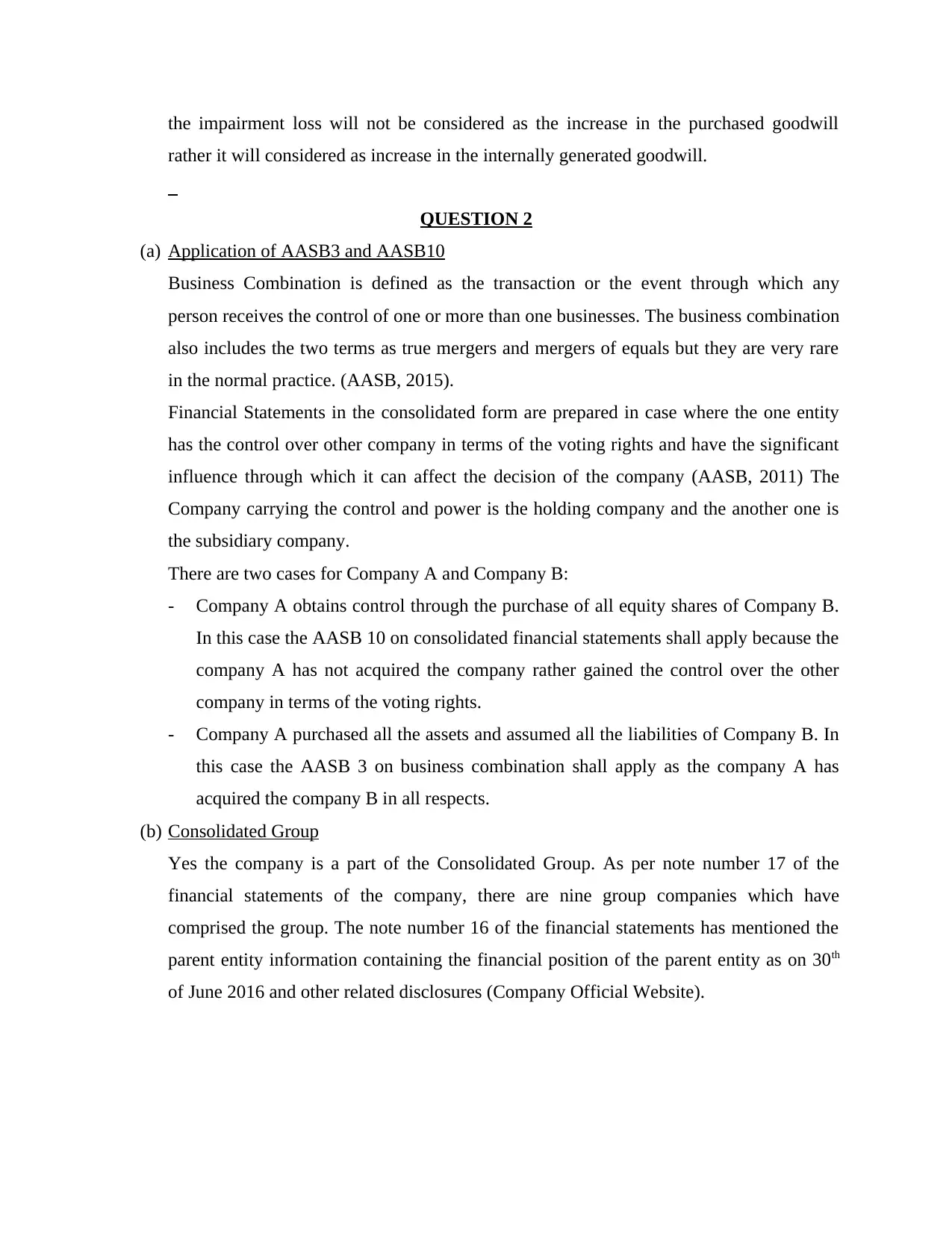
the impairment loss will not be considered as the increase in the purchased goodwill
rather it will considered as increase in the internally generated goodwill.
QUESTION 2
(a) Application of AASB3 and AASB10
Business Combination is defined as the transaction or the event through which any
person receives the control of one or more than one businesses. The business combination
also includes the two terms as true mergers and mergers of equals but they are very rare
in the normal practice. (AASB, 2015).
Financial Statements in the consolidated form are prepared in case where the one entity
has the control over other company in terms of the voting rights and have the significant
influence through which it can affect the decision of the company (AASB, 2011) The
Company carrying the control and power is the holding company and the another one is
the subsidiary company.
There are two cases for Company A and Company B:
- Company A obtains control through the purchase of all equity shares of Company B.
In this case the AASB 10 on consolidated financial statements shall apply because the
company A has not acquired the company rather gained the control over the other
company in terms of the voting rights.
- Company A purchased all the assets and assumed all the liabilities of Company B. In
this case the AASB 3 on business combination shall apply as the company A has
acquired the company B in all respects.
(b) Consolidated Group
Yes the company is a part of the Consolidated Group. As per note number 17 of the
financial statements of the company, there are nine group companies which have
comprised the group. The note number 16 of the financial statements has mentioned the
parent entity information containing the financial position of the parent entity as on 30th
of June 2016 and other related disclosures (Company Official Website).
rather it will considered as increase in the internally generated goodwill.
QUESTION 2
(a) Application of AASB3 and AASB10
Business Combination is defined as the transaction or the event through which any
person receives the control of one or more than one businesses. The business combination
also includes the two terms as true mergers and mergers of equals but they are very rare
in the normal practice. (AASB, 2015).
Financial Statements in the consolidated form are prepared in case where the one entity
has the control over other company in terms of the voting rights and have the significant
influence through which it can affect the decision of the company (AASB, 2011) The
Company carrying the control and power is the holding company and the another one is
the subsidiary company.
There are two cases for Company A and Company B:
- Company A obtains control through the purchase of all equity shares of Company B.
In this case the AASB 10 on consolidated financial statements shall apply because the
company A has not acquired the company rather gained the control over the other
company in terms of the voting rights.
- Company A purchased all the assets and assumed all the liabilities of Company B. In
this case the AASB 3 on business combination shall apply as the company A has
acquired the company B in all respects.
(b) Consolidated Group
Yes the company is a part of the Consolidated Group. As per note number 17 of the
financial statements of the company, there are nine group companies which have
comprised the group. The note number 16 of the financial statements has mentioned the
parent entity information containing the financial position of the parent entity as on 30th
of June 2016 and other related disclosures (Company Official Website).
⊘ This is a preview!⊘
Do you want full access?
Subscribe today to unlock all pages.

Trusted by 1+ million students worldwide
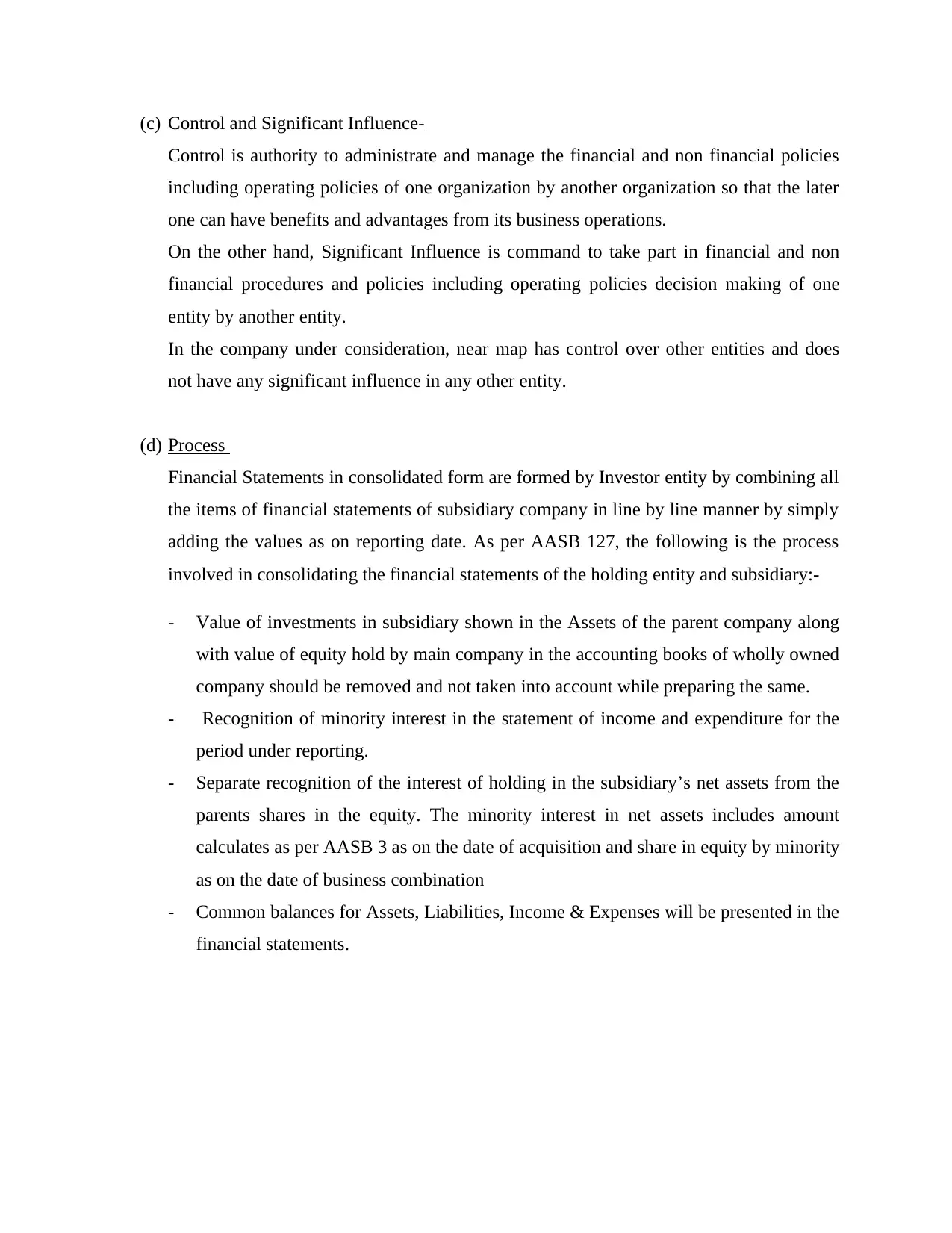
(c) Control and Significant Influence-
Control is authority to administrate and manage the financial and non financial policies
including operating policies of one organization by another organization so that the later
one can have benefits and advantages from its business operations.
On the other hand, Significant Influence is command to take part in financial and non
financial procedures and policies including operating policies decision making of one
entity by another entity.
In the company under consideration, near map has control over other entities and does
not have any significant influence in any other entity.
(d) Process
Financial Statements in consolidated form are formed by Investor entity by combining all
the items of financial statements of subsidiary company in line by line manner by simply
adding the values as on reporting date. As per AASB 127, the following is the process
involved in consolidating the financial statements of the holding entity and subsidiary:-
- Value of investments in subsidiary shown in the Assets of the parent company along
with value of equity hold by main company in the accounting books of wholly owned
company should be removed and not taken into account while preparing the same.
- Recognition of minority interest in the statement of income and expenditure for the
period under reporting.
- Separate recognition of the interest of holding in the subsidiary’s net assets from the
parents shares in the equity. The minority interest in net assets includes amount
calculates as per AASB 3 as on the date of acquisition and share in equity by minority
as on the date of business combination
- Common balances for Assets, Liabilities, Income & Expenses will be presented in the
financial statements.
Control is authority to administrate and manage the financial and non financial policies
including operating policies of one organization by another organization so that the later
one can have benefits and advantages from its business operations.
On the other hand, Significant Influence is command to take part in financial and non
financial procedures and policies including operating policies decision making of one
entity by another entity.
In the company under consideration, near map has control over other entities and does
not have any significant influence in any other entity.
(d) Process
Financial Statements in consolidated form are formed by Investor entity by combining all
the items of financial statements of subsidiary company in line by line manner by simply
adding the values as on reporting date. As per AASB 127, the following is the process
involved in consolidating the financial statements of the holding entity and subsidiary:-
- Value of investments in subsidiary shown in the Assets of the parent company along
with value of equity hold by main company in the accounting books of wholly owned
company should be removed and not taken into account while preparing the same.
- Recognition of minority interest in the statement of income and expenditure for the
period under reporting.
- Separate recognition of the interest of holding in the subsidiary’s net assets from the
parents shares in the equity. The minority interest in net assets includes amount
calculates as per AASB 3 as on the date of acquisition and share in equity by minority
as on the date of business combination
- Common balances for Assets, Liabilities, Income & Expenses will be presented in the
financial statements.
Paraphrase This Document
Need a fresh take? Get an instant paraphrase of this document with our AI Paraphraser
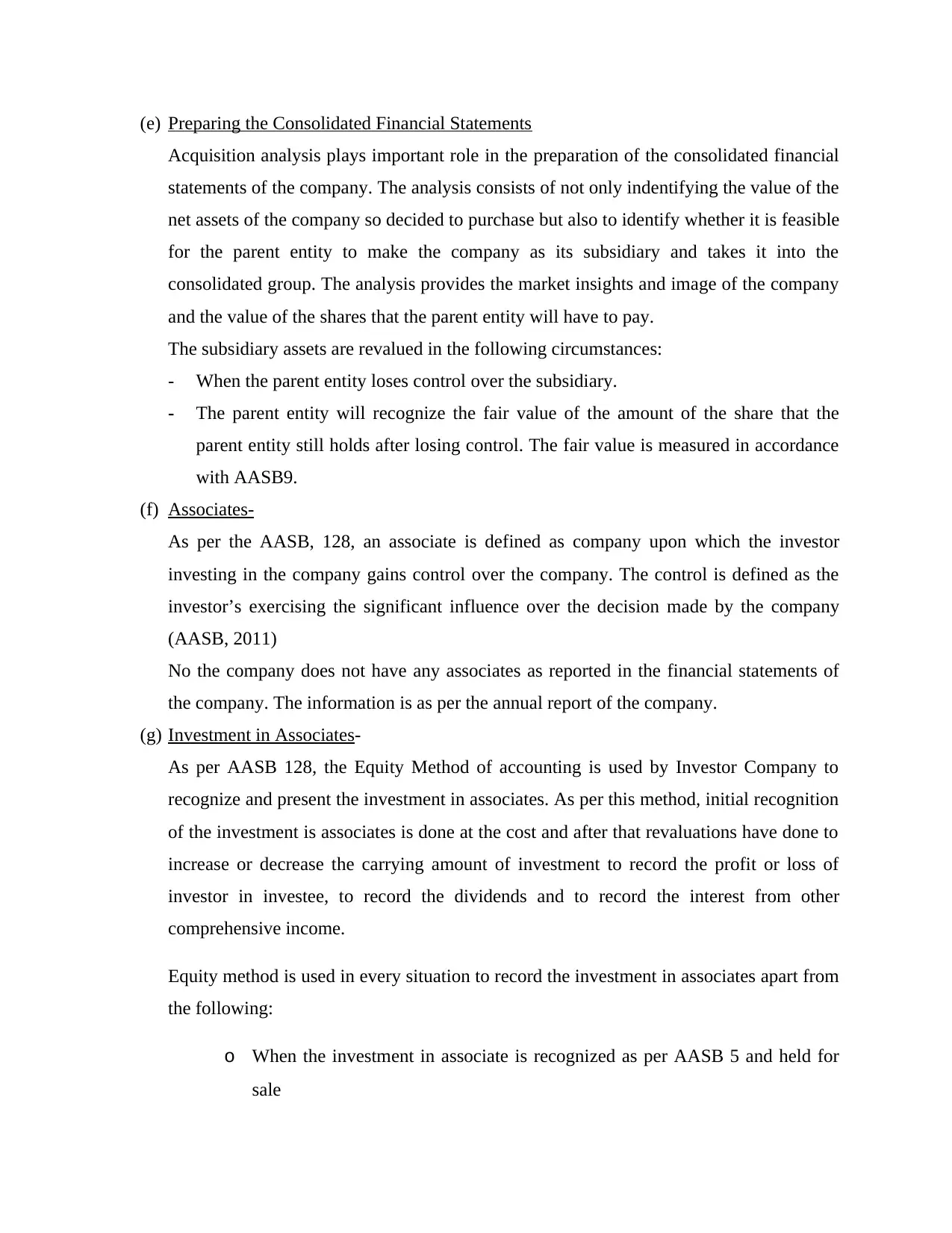
(e) Preparing the Consolidated Financial Statements
Acquisition analysis plays important role in the preparation of the consolidated financial
statements of the company. The analysis consists of not only indentifying the value of the
net assets of the company so decided to purchase but also to identify whether it is feasible
for the parent entity to make the company as its subsidiary and takes it into the
consolidated group. The analysis provides the market insights and image of the company
and the value of the shares that the parent entity will have to pay.
The subsidiary assets are revalued in the following circumstances:
- When the parent entity loses control over the subsidiary.
- The parent entity will recognize the fair value of the amount of the share that the
parent entity still holds after losing control. The fair value is measured in accordance
with AASB9.
(f) Associates-
As per the AASB, 128, an associate is defined as company upon which the investor
investing in the company gains control over the company. The control is defined as the
investor’s exercising the significant influence over the decision made by the company
(AASB, 2011)
No the company does not have any associates as reported in the financial statements of
the company. The information is as per the annual report of the company.
(g) Investment in Associates-
As per AASB 128, the Equity Method of accounting is used by Investor Company to
recognize and present the investment in associates. As per this method, initial recognition
of the investment is associates is done at the cost and after that revaluations have done to
increase or decrease the carrying amount of investment to record the profit or loss of
investor in investee, to record the dividends and to record the interest from other
comprehensive income.
Equity method is used in every situation to record the investment in associates apart from
the following:
o When the investment in associate is recognized as per AASB 5 and held for
sale
Acquisition analysis plays important role in the preparation of the consolidated financial
statements of the company. The analysis consists of not only indentifying the value of the
net assets of the company so decided to purchase but also to identify whether it is feasible
for the parent entity to make the company as its subsidiary and takes it into the
consolidated group. The analysis provides the market insights and image of the company
and the value of the shares that the parent entity will have to pay.
The subsidiary assets are revalued in the following circumstances:
- When the parent entity loses control over the subsidiary.
- The parent entity will recognize the fair value of the amount of the share that the
parent entity still holds after losing control. The fair value is measured in accordance
with AASB9.
(f) Associates-
As per the AASB, 128, an associate is defined as company upon which the investor
investing in the company gains control over the company. The control is defined as the
investor’s exercising the significant influence over the decision made by the company
(AASB, 2011)
No the company does not have any associates as reported in the financial statements of
the company. The information is as per the annual report of the company.
(g) Investment in Associates-
As per AASB 128, the Equity Method of accounting is used by Investor Company to
recognize and present the investment in associates. As per this method, initial recognition
of the investment is associates is done at the cost and after that revaluations have done to
increase or decrease the carrying amount of investment to record the profit or loss of
investor in investee, to record the dividends and to record the interest from other
comprehensive income.
Equity method is used in every situation to record the investment in associates apart from
the following:
o When the investment in associate is recognized as per AASB 5 and held for
sale
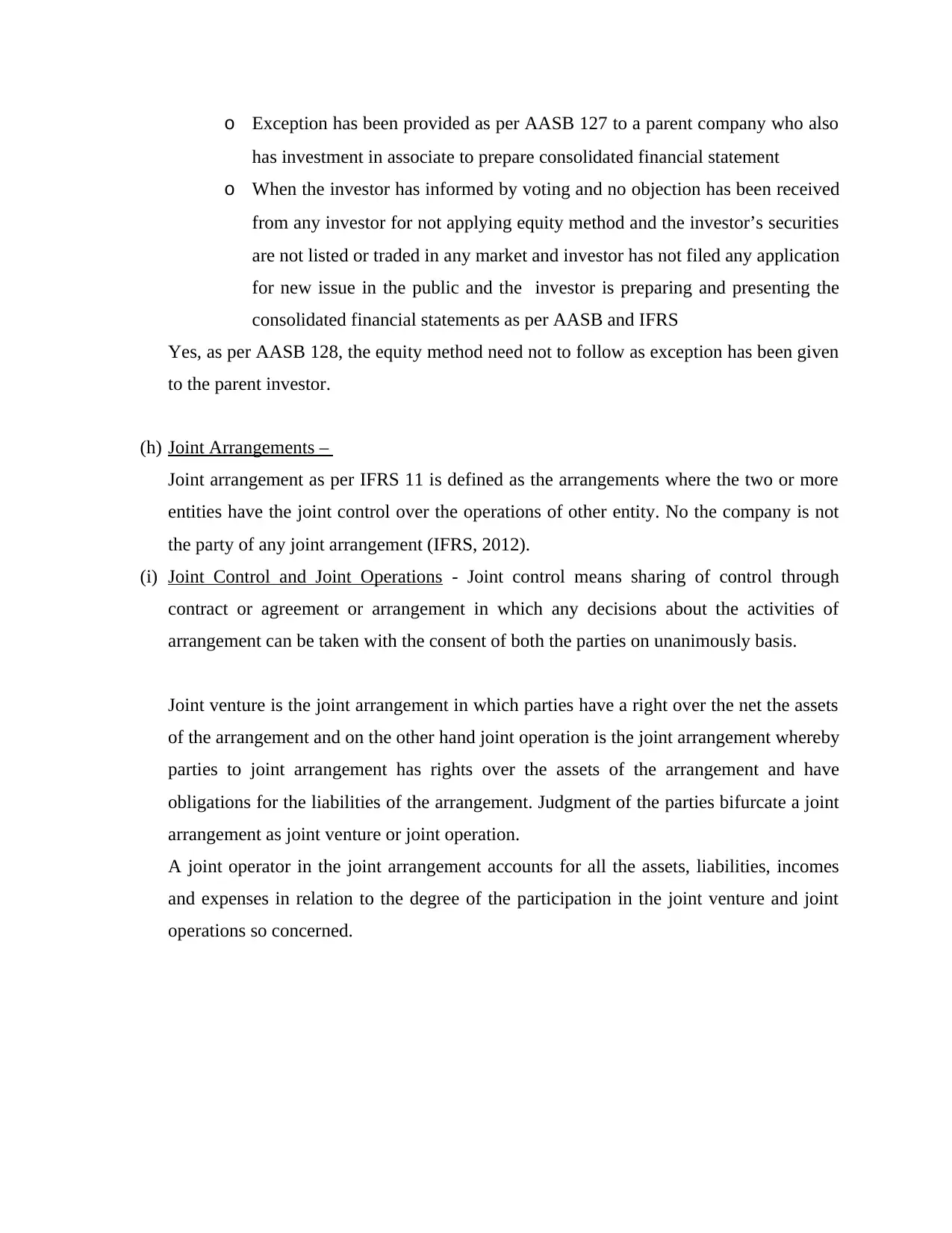
o Exception has been provided as per AASB 127 to a parent company who also
has investment in associate to prepare consolidated financial statement
o When the investor has informed by voting and no objection has been received
from any investor for not applying equity method and the investor’s securities
are not listed or traded in any market and investor has not filed any application
for new issue in the public and the investor is preparing and presenting the
consolidated financial statements as per AASB and IFRS
Yes, as per AASB 128, the equity method need not to follow as exception has been given
to the parent investor.
(h) Joint Arrangements –
Joint arrangement as per IFRS 11 is defined as the arrangements where the two or more
entities have the joint control over the operations of other entity. No the company is not
the party of any joint arrangement (IFRS, 2012).
(i) Joint Control and Joint Operations - Joint control means sharing of control through
contract or agreement or arrangement in which any decisions about the activities of
arrangement can be taken with the consent of both the parties on unanimously basis.
Joint venture is the joint arrangement in which parties have a right over the net the assets
of the arrangement and on the other hand joint operation is the joint arrangement whereby
parties to joint arrangement has rights over the assets of the arrangement and have
obligations for the liabilities of the arrangement. Judgment of the parties bifurcate a joint
arrangement as joint venture or joint operation.
A joint operator in the joint arrangement accounts for all the assets, liabilities, incomes
and expenses in relation to the degree of the participation in the joint venture and joint
operations so concerned.
has investment in associate to prepare consolidated financial statement
o When the investor has informed by voting and no objection has been received
from any investor for not applying equity method and the investor’s securities
are not listed or traded in any market and investor has not filed any application
for new issue in the public and the investor is preparing and presenting the
consolidated financial statements as per AASB and IFRS
Yes, as per AASB 128, the equity method need not to follow as exception has been given
to the parent investor.
(h) Joint Arrangements –
Joint arrangement as per IFRS 11 is defined as the arrangements where the two or more
entities have the joint control over the operations of other entity. No the company is not
the party of any joint arrangement (IFRS, 2012).
(i) Joint Control and Joint Operations - Joint control means sharing of control through
contract or agreement or arrangement in which any decisions about the activities of
arrangement can be taken with the consent of both the parties on unanimously basis.
Joint venture is the joint arrangement in which parties have a right over the net the assets
of the arrangement and on the other hand joint operation is the joint arrangement whereby
parties to joint arrangement has rights over the assets of the arrangement and have
obligations for the liabilities of the arrangement. Judgment of the parties bifurcate a joint
arrangement as joint venture or joint operation.
A joint operator in the joint arrangement accounts for all the assets, liabilities, incomes
and expenses in relation to the degree of the participation in the joint venture and joint
operations so concerned.
⊘ This is a preview!⊘
Do you want full access?
Subscribe today to unlock all pages.

Trusted by 1+ million students worldwide
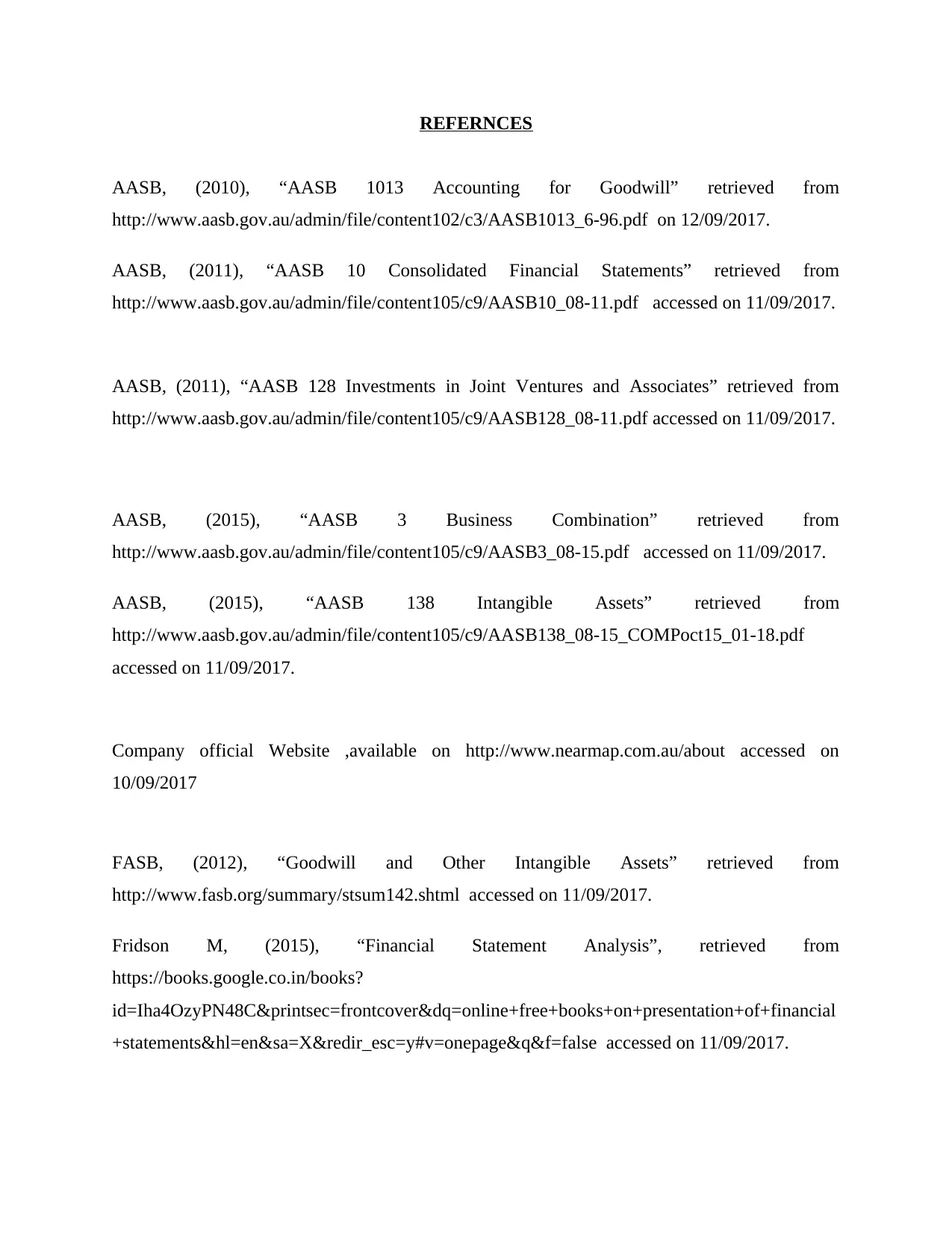
REFERNCES
AASB, (2010), “AASB 1013 Accounting for Goodwill” retrieved from
http://www.aasb.gov.au/admin/file/content102/c3/AASB1013_6-96.pdf on 12/09/2017.
AASB, (2011), “AASB 10 Consolidated Financial Statements” retrieved from
http://www.aasb.gov.au/admin/file/content105/c9/AASB10_08-11.pdf accessed on 11/09/2017.
AASB, (2011), “AASB 128 Investments in Joint Ventures and Associates” retrieved from
http://www.aasb.gov.au/admin/file/content105/c9/AASB128_08-11.pdf accessed on 11/09/2017.
AASB, (2015), “AASB 3 Business Combination” retrieved from
http://www.aasb.gov.au/admin/file/content105/c9/AASB3_08-15.pdf accessed on 11/09/2017.
AASB, (2015), “AASB 138 Intangible Assets” retrieved from
http://www.aasb.gov.au/admin/file/content105/c9/AASB138_08-15_COMPoct15_01-18.pdf
accessed on 11/09/2017.
Company official Website ,available on http://www.nearmap.com.au/about accessed on
10/09/2017
FASB, (2012), “Goodwill and Other Intangible Assets” retrieved from
http://www.fasb.org/summary/stsum142.shtml accessed on 11/09/2017.
Fridson M, (2015), “Financial Statement Analysis”, retrieved from
https://books.google.co.in/books?
id=Iha4OzyPN48C&printsec=frontcover&dq=online+free+books+on+presentation+of+financial
+statements&hl=en&sa=X&redir_esc=y#v=onepage&q&f=false accessed on 11/09/2017.
AASB, (2010), “AASB 1013 Accounting for Goodwill” retrieved from
http://www.aasb.gov.au/admin/file/content102/c3/AASB1013_6-96.pdf on 12/09/2017.
AASB, (2011), “AASB 10 Consolidated Financial Statements” retrieved from
http://www.aasb.gov.au/admin/file/content105/c9/AASB10_08-11.pdf accessed on 11/09/2017.
AASB, (2011), “AASB 128 Investments in Joint Ventures and Associates” retrieved from
http://www.aasb.gov.au/admin/file/content105/c9/AASB128_08-11.pdf accessed on 11/09/2017.
AASB, (2015), “AASB 3 Business Combination” retrieved from
http://www.aasb.gov.au/admin/file/content105/c9/AASB3_08-15.pdf accessed on 11/09/2017.
AASB, (2015), “AASB 138 Intangible Assets” retrieved from
http://www.aasb.gov.au/admin/file/content105/c9/AASB138_08-15_COMPoct15_01-18.pdf
accessed on 11/09/2017.
Company official Website ,available on http://www.nearmap.com.au/about accessed on
10/09/2017
FASB, (2012), “Goodwill and Other Intangible Assets” retrieved from
http://www.fasb.org/summary/stsum142.shtml accessed on 11/09/2017.
Fridson M, (2015), “Financial Statement Analysis”, retrieved from
https://books.google.co.in/books?
id=Iha4OzyPN48C&printsec=frontcover&dq=online+free+books+on+presentation+of+financial
+statements&hl=en&sa=X&redir_esc=y#v=onepage&q&f=false accessed on 11/09/2017.
Paraphrase This Document
Need a fresh take? Get an instant paraphrase of this document with our AI Paraphraser
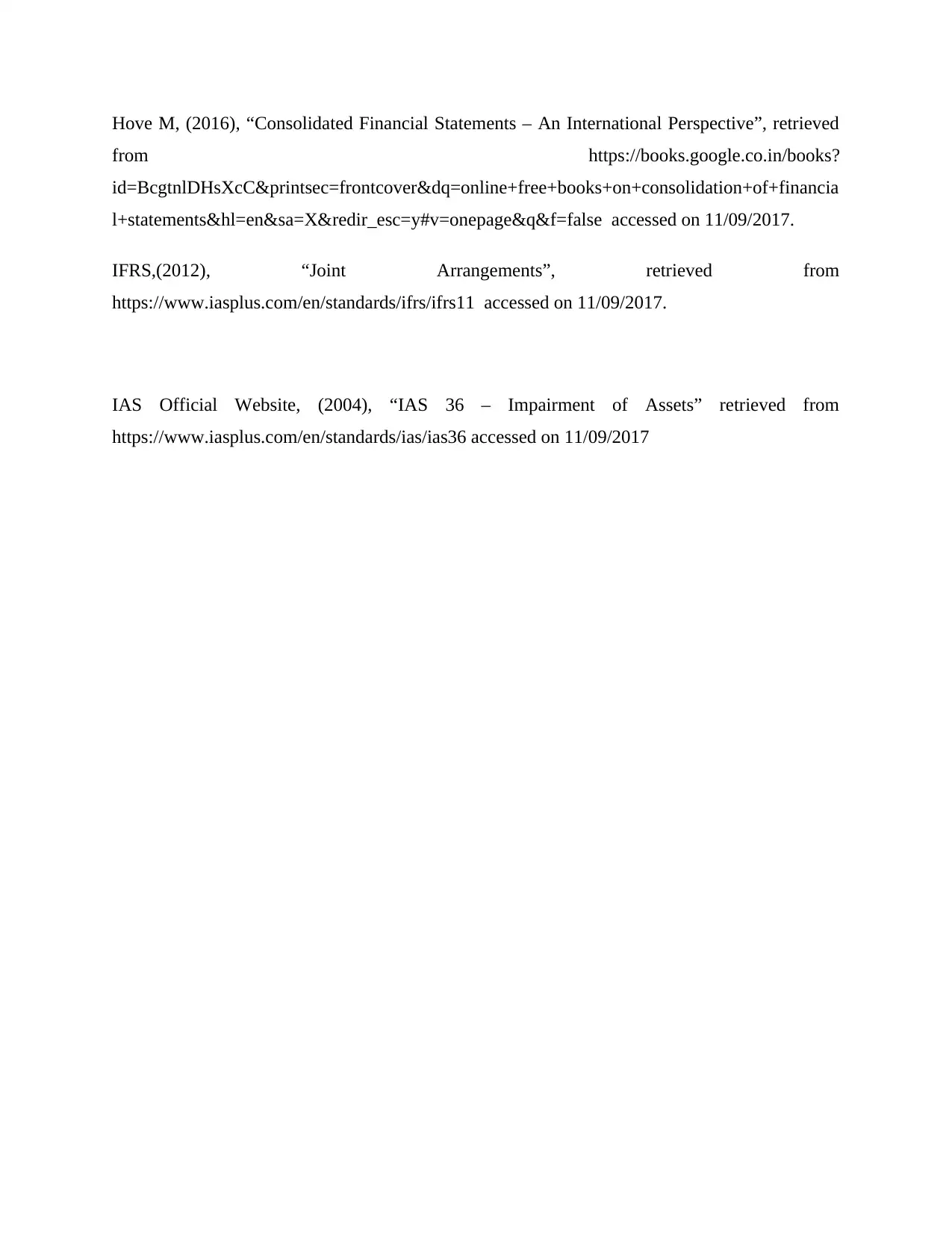
Hove M, (2016), “Consolidated Financial Statements – An International Perspective”, retrieved
from https://books.google.co.in/books?
id=BcgtnlDHsXcC&printsec=frontcover&dq=online+free+books+on+consolidation+of+financia
l+statements&hl=en&sa=X&redir_esc=y#v=onepage&q&f=false accessed on 11/09/2017.
IFRS,(2012), “Joint Arrangements”, retrieved from
https://www.iasplus.com/en/standards/ifrs/ifrs11 accessed on 11/09/2017.
IAS Official Website, (2004), “IAS 36 – Impairment of Assets” retrieved from
https://www.iasplus.com/en/standards/ias/ias36 accessed on 11/09/2017
from https://books.google.co.in/books?
id=BcgtnlDHsXcC&printsec=frontcover&dq=online+free+books+on+consolidation+of+financia
l+statements&hl=en&sa=X&redir_esc=y#v=onepage&q&f=false accessed on 11/09/2017.
IFRS,(2012), “Joint Arrangements”, retrieved from
https://www.iasplus.com/en/standards/ifrs/ifrs11 accessed on 11/09/2017.
IAS Official Website, (2004), “IAS 36 – Impairment of Assets” retrieved from
https://www.iasplus.com/en/standards/ias/ias36 accessed on 11/09/2017
1 out of 8
Related Documents
Your All-in-One AI-Powered Toolkit for Academic Success.
+13062052269
info@desklib.com
Available 24*7 on WhatsApp / Email
![[object Object]](/_next/static/media/star-bottom.7253800d.svg)
Unlock your academic potential
Copyright © 2020–2025 A2Z Services. All Rights Reserved. Developed and managed by ZUCOL.




